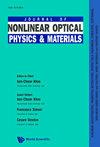Requisites on material viscoelasticity for exceptional points in passive dynamical systems
IF 2.3
4区 物理与天体物理
Q2 OPTICS
引用次数: 0
Abstract
Recent progress in non-Hermitian physics and the notion of exceptional point (EP) degeneracies in elastodynamics have led to the development of novel metamaterials for the control of elastic wave propagation, hypersensitive sensors, and actuators. The emergence of EPs in a parity-time symmetric system relies on judiciously engineered balanced gain and loss mechanisms. Creating gain requires complex circuits and amplification mechanisms, making engineering applications challenging. Here, we report strategies to achieve EPs in passive non-Hermitian elastodynamic systems with differential loss derived from viscoelastic materials. We compare different viscoelastic material models and show that the EP emerges only when the frequency-dependent loss-tangent of the viscoelastic material remains nearly constant in the frequency range of operation. This type of loss tangent occurs in materials that undergo stress-relaxation over a broad spectrum of relaxation times, for example, materials that follow the Kelvin–Voigt fractional derivative (KVFD) model. Using dynamic mechanical analysis, we show that a few common viscoelastic elastomers, such as polydimethylsiloxane and polyurethane rubber, follow the KVFD behavior such that the loss tangent becomes almost constant after a particular frequency. The material models we present and the demonstration of the potential of a widely available material system in creating EPs pave the way for developing non-Hermitian metamaterials with hypersensitivity to perturbations or enhanced emissivity.被动动力系统中异常点的材料粘弹性要求
非厄米物理的最新进展和弹性动力学中异常点简并的概念导致了用于控制弹性波传播、超灵敏传感器和致动器的新型超材料的发展。在奇偶时间对称系统中出现的EPs依赖于明智地设计平衡的增益和损失机制。创建增益需要复杂的电路和放大机制,使工程应用具有挑战性。在这里,我们报告了在具有粘弹性材料微分损失的被动非厄米弹性动力系统中实现EPs的策略。我们比较了不同的粘弹性材料模型,并表明只有当粘弹性材料的频率相关损失切线在工作频率范围内保持接近恒定时,才会出现EP。这种类型的损耗正切发生在经历应力松弛的材料中,例如,遵循Kelvin-Voigt分数导数(KVFD)模型的材料。通过动态力学分析,我们发现一些常见的粘弹性弹性体,如聚二甲基硅氧烷和聚氨酯橡胶,遵循KVFD行为,使得损耗切线在特定频率后几乎保持不变。我们提出的材料模型以及广泛可用的材料系统在制造EPs方面的潜力的展示,为开发对扰动超敏感或增强发射率的非厄米特超材料铺平了道路。
本文章由计算机程序翻译,如有差异,请以英文原文为准。
求助全文
约1分钟内获得全文
求助全文
来源期刊
CiteScore
3.00
自引率
48.10%
发文量
53
审稿时长
3 months
期刊介绍:
This journal is devoted to the rapidly advancing research and development in the field of nonlinear interactions of light with matter. Topics of interest include, but are not limited to, nonlinear optical materials, metamaterials and plasmonics, nano-photonic structures, stimulated scatterings, harmonic generations, wave mixing, real time holography, guided waves and solitons, bistabilities, instabilities and nonlinear dynamics, and their applications in laser and coherent lightwave amplification, guiding, switching, modulation, communication and information processing. Original papers, comprehensive reviews and rapid communications reporting original theories and observations are sought for in these and related areas. This journal will also publish proceedings of important international meetings and workshops. It is intended for graduate students, scientists and researchers in academic, industrial and government research institutions.

 求助内容:
求助内容: 应助结果提醒方式:
应助结果提醒方式:


